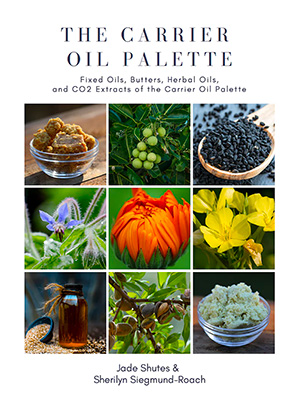Tamanu Oil
Calophyllum inophyllum

Tamanu Oil is also known as Foraha Oil and Calophyllum Oil.
I love keeping Tamanu Oil on hand because I have found it to be helpful for easing pain and reducing inflammation. I include it in the personal blends that I use for restorative skin concerns, and I've found it helpful in gradually reducing the appearance of scars.
Tamanu Oil is a deeper colored oil with a distinctive, nutty aroma. Someone once remarked that Tamanu Oil smells somewhat like butter pecan ice cream, and I agree with that.
Tamanu Oil isn't a particularly thin or light oil, but it absorbs reasonably well. Upon application, it leaves a very thin barrier that seems to help protect the skin. This is likely due to its natural composition of plant waxes. If desired, it can be easily blended with lighter carriers to create a lighter carrier oil blend.
The constituent profile shown for Tamanu Oil in Carrier Oils for Aromatherapy & Massage indicates that Tamanu Oil is comprised of approximately 20% saturated, 40% monounsaturated and 40% polyunsaturated fatty acids. It also contains the anti-inflammatory coumarin known as calophyllolide as well as waxes and other beneficial compounds.
Primary Fatty Acids in Tamanu Oil
- C16:0 Palmitic Acid (Saturated): 12-15%
- C18:0 Stearic Acid (Saturated): 8-13%
- C18:1 Oleic Acid (Monounsaturated Omega-9): 35-49%
- C18:2 Linoleic Acid (Polyunsaturated Omega-6): 21-40%
- C18:3 a-Linolenic Acid (Polyunsaturated Omega-3 EFA): 0.3-1.3%
Source: Len Price with Ian Smith and Shirley Price, Carrier Oils for Aromatherapy & Massage, 4th Edition, Fourth Impression (United Kingdom: Riverhead, 2014), 200.
Botanical Name
Calophyllum inophyllum
Typical Method of Production
Cold Pressed
Aroma
Strong, nutty aroma.
Viscosity
Medium - Thick
Absorption/Feel
Moderate absorption with slightly oily feel if used in excess
Color
Dark Green - Dark Greenish Brown
Shelf Life
1-2 Years
Important Information
The information provided on AromaWeb is for educational purposes only. This data is not considered complete and is not guaranteed to be accurate.
General Safety Information
Use caution when trying any new ingredient, including carrier oils on the skin or in the hair. Those with nut allergies should consult their medical practitioner before coming into contact with nut oils, butters or other nut products. Do not take any oils internally without consultation from a qualified aromatherapy practitioner. Safety information can be found by visiting the Safety Information page. For very in-depth information on oil safety issues, read Essential Oil Safety by Robert Tisserand.
Carrier Oil Book Suggestions
Click on a book's title to view details and read a full review for the book. Visit AromaWeb's Books area to find details about many other essential oil and aromatherapy books.

The Carrier Oil Palette: Fixed Oils, Butters, Herbal Oils, and CO2 Extracts of the Carrier Oil Palette
Authors: Jade Shutes & Sherilyn Siegmund-Roach

Power of the Seed: Your Guide to Oils for Health & Beauty
Author: Susan M. Parker

Carrier Oils for Aromatherapy & Massage
Authors: Len Price with Ian Smith & Shirley Price
